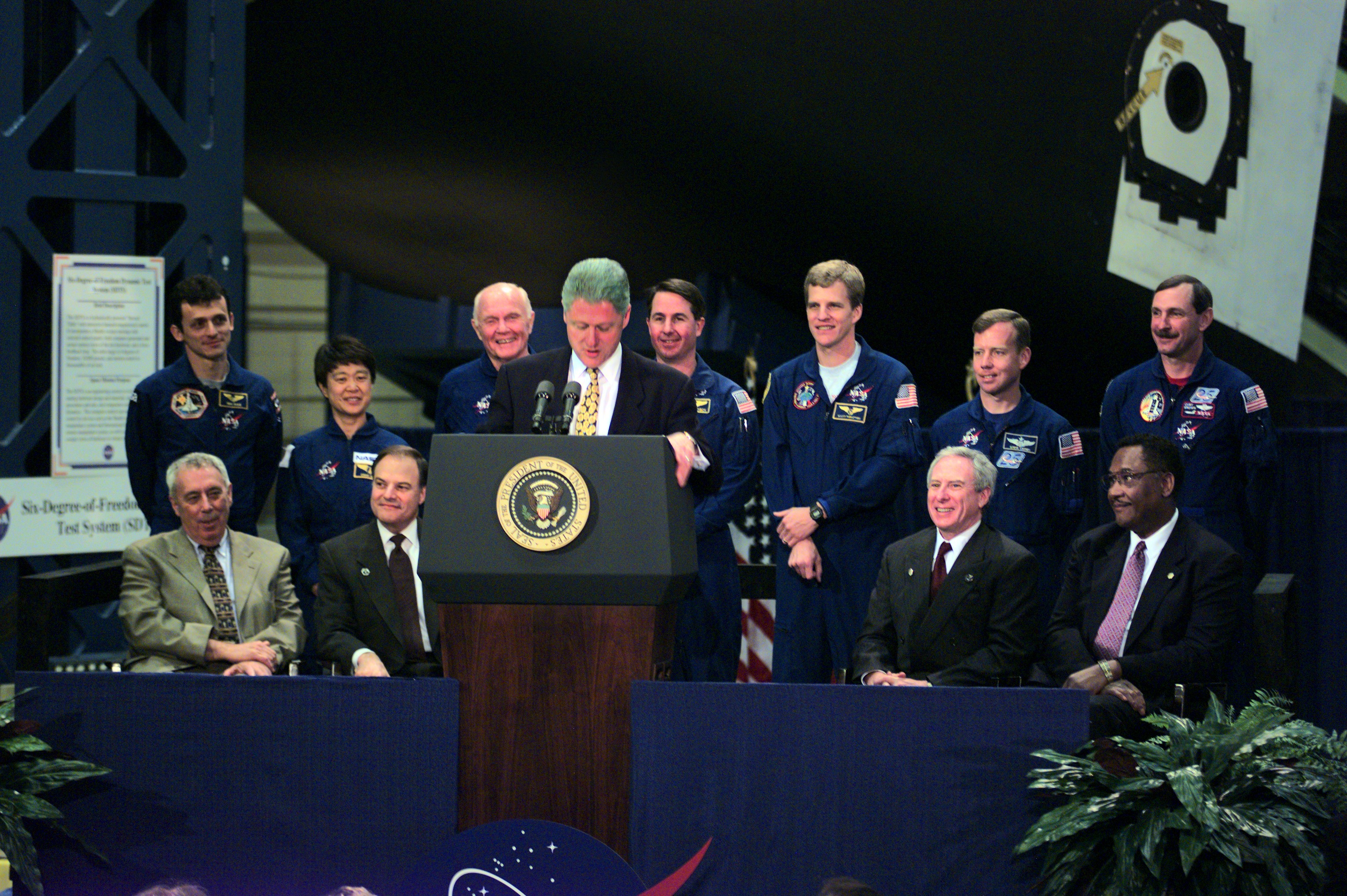
Three weeks before the New Era began, the Old Era ended.
Today, 1998 is remembered as the year in which the on-orbit fabrication of the International Space Station (ISS) got underway. Yet another highlight of that year was the return to space of one of America’s “Original Seven” Mercury astronauts—77-year-old John Glenn—which secured him the title of the oldest human ever to rocket beyond Earth’s atmosphere. It is a title which Glenn retains to this very day and his mission aboard Space Shuttle Discovery in October 1998 served to unite the old era with the new. That said, his return to flight and the motivation of NASA were met with praise and criticism.
Late in the summer of 1997, the rumor mill became rife with speculation that Glenn—more than three decades after becoming America’s first man to orbit the Home Planet and later the Democratic Senator for Ohio and one-time contender for the White House—might fly a shuttle mission to better understand the process of aging in microgravity. Several months later, in January 1998, Glenn was formally assigned as a Payload Specialist on STS-95, a research mission, scheduled for launch aboard Shuttle Discovery in October. On-board would be a commercial Spacehab pressurized module, laden with scientific experiments, as well as the deployable Shuttle Pointed Autonomous Research Tool for Astronomy (SPARTAN) free-flyer and a battery of other payloads. However, despite STS-95’s emphasis upon science, some observers saw the flight as little more than an inexcusably rash publicity stunt.
NASA had been harshly criticized in the wake of the 1986 Challenger accident for a practice of flying non-professional “passengers” aboard the shuttle, most famously the schoolteacher Christa McAuliffe. In order to gain approval from NASA Administrator Dan Goldin—as outlined in yesterday’s AmericaSpace history article—Glenn had to complete a battery of medical and other proficiency tests, as well as ensure that the scientific thrust of his mission stood up to scrutiny. At the same time, McAuliffe’s backup, former teacher Barbara Morgan, was under consideration to begin training as a fully fledged astronaut. “We are not reviving the civilian-in-space program,” Goldin said at the time. “We are asking people to go through the formal process. As we’re trying to get biologists and geologists because of the tremendous findings we’re having in planetary science, education is a prime mission of NASA. We want scientifically developed educators to participate.” Just as Morgan would fulfil a complete Mission Specialist training syllabus, so Glenn would do likewise on the Payload Specialist track.
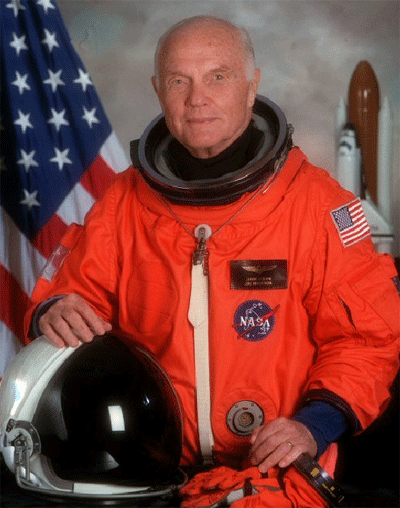
If there was one message to emerge from Glenn’s mission, it was the fact that elderly people no longer had to be barred from life experiences on the basis of their age. In his 1999 autobiography, John Glenn: A Memoir, he remembered an elderly couple stopping him at an airport whilst training and telling him that he had changed their lives for the better. For years, the couple told Glenn, they had been putting off a planned trip of a lifetime to climb Mount Kilimanjaro, as life, work, and children entered their lives. Eventually, they considered themselves too old … until NASA announced that it was flying Glenn on the shuttle. The husband then turned to his wife and told her that if John Glenn could return to space at the age of 77, then they could certainly climb the fabled African peak. They duly booked tickets to do it. “More than anything,” wrote Glenn, “I think the excitement surrounding my return to space was due to that redefinition of what people could expect of the elderly and what the elderly could expect of themselves.”
Although STS-95’s medical experiments carried a clear slant toward the study of aging in space, some journalists doubted that having a single data point—Glenn himself—was hardly sufficient for a long-term program. Glenn disagreed. “You’ve got to start somewhere,” he said. “I hope eventually we have a very large database out of all this. If I’m fortunate to be the one to start, I’m honored to be the first data point on the new chart.” Others queried why, if NASA’s focus was upon older astronauts, none had been formally selected in earlier classes. Story Musgrave, who flew aged 61 in the fall of 1996, added that NASA needed to be honest about its decision to launch Glenn. “We are flying a legislative passenger, as we have in the past,” he said. “It’s John Glenn. Marvelous. But it is a legislative passenger.”
Musgrave also pointed out that Glenn did not devote himself, full-time to the mission, an assertion which the senator admitted. “We in the Senate normally go for about three to five weeks, then we have a week or two where people are back in their states,” he told a NASA interviewer in August 1998, “and I’ve used those periods to be in Houston or over at the Cape, training with the crew. And all this month of August, the Senate is out of session, so I’ll be here. I’m here all during this month and then we will go out of session in very early October and I’ll be here training continually from that time on.”
Three weeks after Glenn was announced to join the STS-95 mission, in February 1998 the remainder of the crew was announced. All but one were veterans, and yet all were starstruck by their crewmate. Commander Curt Brown was six years old when Glenn flew his Mercury mission and remembered Friendship 7 as “a big, significant event in my life.” Pilot Steve Lindsey—who went on to serve as Chief Astronaut—was surprised to even meet one of the Original Seven, much less fly into space with the first American to orbit Earth. Mission Specialist Steve Robinson agreed with Lindsey, considering his chances of flying with Glenn as “impossible, squared,” whilst Scott Parazynski likened the opportunity to climbing Mount Everest with Sir Edmund Hillary or playing baseball with Babe Ruth. “This, for an astronaut,” said Parazynski, “is about as exciting as it gets.”
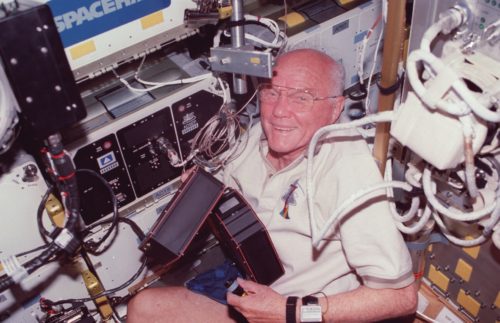
Joined by Spain’s first national spacefarer, Pedro Duque, and veteran Japanese astronaut Chiaki Mukai, the seven-strong crew of STS-95 would support more than 80 experiments in the pressurzed confines of both the Spacehab and Shuttle Discovery’s middeck. Moreover, they would deploy the SPARTAN free-flyer for two days of solar physics observations, before retrieving it with the Remote Manipulator System (RMS) mechanical arm and support a range of other external payloads.
When Discovery launched at 2:19 p.m. EDT on 29 October 1998, no fewer than a quarter-million wellwishers packed the roads and beaches of Cape Canaveral. Seconds after liftoff, a small aluminum panel, located under the shuttle’s vertical stabilizer and meant to cover the drag chute, somehow became detached and fell away. Although its absence was not expected to adversely affect the mission, managers could not be sure if the drag chute had been damaged or destroyed entirely during ascent. Consequently, they elected not to deploy the chute during Discovery’s landing on 7 November, although Lindsey was instructed to quickly press the ARM, DEPLOY, and JETTISON switches to release it on the runway if problems cropped up.
In the meantime, three hours after launch, Glenn sent his first message to Mission Control, as Discovery flew over Hawaii. “Hello, Houston, this is PS2 and they got me sprung out of the middeck for a little while,” he said. “We are just going by Hawaii and that is absolutely gorgeous.” In Mission Control, Capcom Bob Curbeam replied that he was glad that Glenn was enjoying the show. “Enjoying the show is right,” continued the world’s first septuagenarian astronaut. Then, quoting a famous line from his Friendship 7 mission, more than 36 years earlier, he said: “The best part is … a trite old statement, Zero-G and I feel fine!” Less than two hours later, as Glenn exceeded the four hours and 55 minutes he had spent in flight aboard Friendship 7, Curt Brown noted that STS-95 had helped the senator to double his spaceflight endurance log time.
“Let the record show,” Brown reported, “that John has a smile on his face that goes from one ear to the other and we haven’t been able to remove it yet!” And that smile remained, figuratively and literally, for the next nine days.
Nearly two decades later, aged 95, Glenn is the only member of the Original Seven still alive and his record for the oldest living human ever to journey into space is still unchallenged. Despite the increasing likelihood that commercial entities will begin sending private citizens into orbit in the coming years, it seems highly likely that John Glenn’s record will continue to endure for some time to come.
This is part of a series of history articles, which will appear each weekend, barring any major news stories. Next week’s article will focus on the 50th anniversary of Gemini XII, the final mission of Project Gemini, during which rendezvous, docking, and Extravehicular Activity (EVA) were demonstrated prior to the dawn of Project Apollo.
Want to keep up-to-date with all things space? Be sure to “Like” AmericaSpace on Facebook and follow us on Twitter: @AmericaSpace




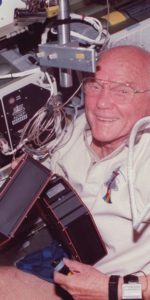
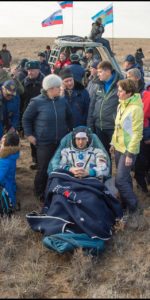
God bless John Glenn and thank you, sir, for your service to our country and for your remarkable contributions to our space program. YOU will always be cherished in our hearts.